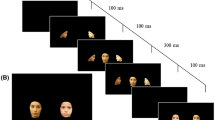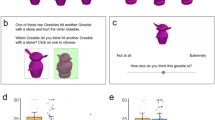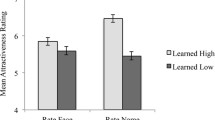Abstract
Information drawn from faces at the very first encounter can be essential in guiding current and subsequent behavior. These decisions also rely on expectations about what are the characteristic features of those who can be trusted or not. After novel experiences these expectations will be revised, and the facial prototypes stored in the memory will be updated. The aim of the recent experiment was to test whether behavioral information about individuals will be transferred to composite facial images. We created composite faces of individual images which were previously presented with either positive or negative behavioral descriptions. We found that the composite made from faces shown with traits referring to high social desirability, was rated as significantly more trustworthy. We propose that exposure to faces and acquisition of socially relevant information shape facial prototypes, ensuring that the evaluation of unknown individuals reflects expectations based on real-life experiences. We further propose that this process is mediated by the generalization of behavior information and facial features, rather than the detection of visual similarity.



Similar content being viewed by others
References
Allport, G. W. (1954). The nature of prejudice. Cambridge: MA: AddisonWesley.
Andersen, S. M., & Baum, A. (1994). Transference in interpersonal relations: inferences and affect based on significant-other representations. Journal of Personality, 62(4), 459–497.
Andersen, S. M., & Chen, S. (2002). The relational self: an interpersonal social-cognitive theory. Psychological Review, 109(4), 619–645.
Bar, M., Neta, M., & Linz, H. (2006). Very first impressions. Emotion, 6(2), 269–278. doi:10.1037/1528-3542.6.2.269.
Berk, M. S., & Andersen, S. M. (2000). The impact of past relationships on interpersonal behavior: behavioral confirmation in the social-cognitive process of transference. Journal of Personality and Social Psychology, 79(4), 546–562.
Biernat, M., Manis, M., & Nelson, T. E. (1991). Stereotypes and standards of judgment. Journal of Personality and Social Psychology, 60(4), 485–499.
Bliss-Moreau, E., Barrett, L. F., & Wright, C. I. (2008). Individual differences in learning the affective value of others under minimal conditions. Emotion (Washington, D.C.), 8(4), 479–493. doi:10.1037/1528-3542.8.4.479.
Bodenhausen, G. V., & Wyer Jr., R. S. (1985). Effects of stereotypes on decision making and information-processing strategies. Journal of Personality and Social Psychology, 48(2), 267–282. doi:10.1037/0022-3514.48.2.267.
Cloutier, J., & Macrae, C. N. (2007). Who or what are you?: facial orientation and person construal. European Journal of Social Psychology, 37(6), 1298–1309. doi:10.1002/ejsp.433.
Cloutier, J., Mason, M. F., & Macrae, C. N. (2005). The perceptual determinants of person construal: reopening the social-cognitive toolbox. Journal of Personality and Social Psychology, 88(6), 885–894. doi:10.1037/0022-3514.88.6.885.
Cook, S. W. (1985). Experimenting on social issues: the case of school desegregation. American Psychologist, 40(4), 452–460. doi:10.1037/0003-066X.40.4.452.
Dewolf, T. (2014). Effects of Attractiveness on Perceived Trustworthiness. Undergraduate Journal of Psychology, 27(1). Retrieved from https://journals.uncc.edu/ujop/article/view/276
Dotsch, R., Wigboldus, D. H. J., & van Knippenberg, A. (2013). Behavioral information biases the expected facial appearance of members of novel groups. European Journal of Social Psychology, 43(1), 116–125. doi:10.1002/ejsp.1928.
Duncan, B. L. (1976). Differential social perception and attribution of intergroup violence: testing the lower limits of stereotyping of blacks. Journal of Personality and Social Psychology, 34(4), 590–598. doi:10.1037/0022-3514.34.4.590.
Engell, A. D., Haxby, J. V., & Todorov, A. (2007). Implicit trustworthiness decisions: automatic coding of face properties in the human amygdala. Journal of Cognitive Neuroscience, 19(9), 1508–1519. doi:10.1162/jocn.2007.19.9.1508.
Gaertner, S. L., Dovidio, J. F., & Bachman, B. A. (1996). Revisiting the contact hypothesis: the induction of a common ingroup identity. International Journal of Intercultural Relations, 20(3–4), 271–290. doi:10.1016/0147-1767(96)00019-3.
Gawronski, B., & Quinn, K. A. (2013). Guilty by mere similarity: assimilative effects of facial resemblance on automatic evaluation. Journal of Experimental Social Psychology, 49(1), 120–125. doi:10.1016/j.jesp.2012.07.016.
Ghirlanda, S., & Enquist, M. (2003). A century of generalization. Animal Behaviour, 66(1), 15–36. doi:10.1006/anbe.2003.2174.
Gilbert, D. T., & Malone, P. S. (1995). The correspondence bias. Psychological Bulletin, 117(1), 21–38. doi:10.1037/0033-2909.117.1.21.
Griffin, A. M., & Langlois, J. H. (2006). Stereotype directionality and attractiveness stereotyping: Is beauty good or is ugly bad? Social Cognition, 24(2), 187–206. doi:10.1521/soco.2006.24.2.187.
Günaydin, G., Zayas, V., Selcuk, E., & Hazan, C. (2012). I like you but I don’t know why: objective facial resemblance to significant others influences snap judgments. Journal of Experimental Social Psychology, 48(1), 350–353. doi:10.1016/j.jesp.2011.06.001.
Heider, J. D., Scherer, C. R., Skowronski, J. J., Wood, S. E., Edlund, J. E., & Hartnett, J. L. (2007). Trait expectancies and stereotype expectancies have the same effect on person memory. Journal of Experimental Social Psychology, 43(2), 265–272. doi:10.1016/j.jesp.2006.01.004.
Heilman, M. E. (1984). Information as a deterrent against sex discrimination: the effects of applicant sex and information type on preliminary employment decisions. Organizational Behavior and Human Performance, 33(2), 174–186. doi:10.1016/0030-5073(84)90019-9.
Hill, T., Lewicki, P., Czyzewska, M., & Schuller, G. (1990). The role of learned inferential encoding rules in the perception of faces: effects of nonconscious self-perpetuation of a bias. Journal of Experimental Social Psychology, 26(4), 350–371. doi:10.1016/0022-1031(90)90044-M.
Hilton, J. L., & von Hippel, W. (1996). Stereotypes. Annual Review of Psychology, 47(1), 237–271. doi:10.1146/annurev.psych.47.1.237.
Imhoff, R., Woelki, J., Hanke, S., & Dotsch, R. (2013). Warmth and competence in your face! visual encoding of stereotype content. Frontiers in Psychology, 4. doi:10.3389/fpsyg.2013.00386.
Jones, B. C., Debruine, L. M., Little, A. C., & Feinberg, D. R. (2007). The valence of experiences with faces influences generalized preferences. Journal of Evolutionary Psychology, 5(1), 119–129. doi:10.1556/JEP.2007.1001.
Kawakami, K., & Dovidio, J. F. (2001). The reliability of implicit stereotyping. Personality and Social Psychology Bulletin, 27(2), 212–225. doi:10.1177/0146167201272007.
Kawakami, K., Dion, K. L., & Dovidio, J. F. (1998). Racial prejudice and stereotype activation. Personality and Social Psychology Bulletin, 24(4), 407–416. doi:10.1177/0146167298244007.
Kawakami, K., Dovidio, J. F., & Dijksterhuis, A. (2003). Effect of social category priming on personal attitudes. Psychological Science, 14(4), 315–319. doi:10.1111/1467-9280.14451.
Kraus, M. W., & Chen, S. (2010). Facial-feature resemblance elicits the transference effect. Psychological Science, 21(4), 518–522. doi:10.1177/0956797610364949.
Kunda, Z., & Sherman-Williams, B. (1993). Stereotypes and the construal of individuating information. Personality and Social Psychology Bulletin, 19(1), 90–99.
Leder, H., & Bruce, V. (2000). When inverted faces are recognized: the role of configural information in face recognition. Quarterly Journal of Experimental Psychology Section A: Human Experimental Psychology, 53(2), 513–536.
Lewicki, P. (1985). Nonconscious biasing effects of single instances on subsequent judgments. Journal of Personality and Social Psychology, 48(3), 563–574. doi:10.1037/0022-3514.48.3.563.
Locksley, A., Borgida, E., Brekke, N., & Hepburn, C. (1980). Sex stereotypes and social judgment. Journal of Personality and Social Psychology, 39(5), 821–831. doi:10.1037/0022-3514.39.5.821.
Maurer, D., Le Grand, R., & Mondloch, C. J. (2002). The many faces of configural processing. Trends in Cognitive Sciences, 6(6), 255–260. doi:10.1016/S1364-6613(02)01903-4.
McGarty, C., Yzerbyt, V. Y., & Spears, R. (Eds.) (2002). Stereotypes as explanations: The formation of meaningful beliefs about social groups. New York: Cambridge University Press.
Nisbett, R. E., Zukier, H., & Lemley, R. E. (1981). The dilution effect: nondiagnostic information weakens the implications of diagnostic information. Cognitive Psychology, 13(2), 248–277. doi:10.1016/0010-0285(81)90010-4.
Pettigrew, T. F. (1998). Intergroup contact theory. Annual Review of Psychology, 49(1), 65–85. doi:10.1146/annurev.psych.49.1.65.
Quinn, K. A., & Macrae, C. N. (2011). The face and person perception: insights from social cognition. British Journal of Psychology, 102(4), 849–867. doi:10.1111/j.2044-8295.2011.02030.x.
Quinn, K. A., & Rosenthal, H. E. S. (2012). Categorizing others and the self: how social memory structures guide social perception and behavior. Learning and Motivation, 43(4), 247–258. doi:10.1016/j.lmot.2012.05.008.
Quinn, K. A., Mason, M. F., & Macrae, C. N. (2009). Familiarity and person construal: individuating knowledge moderates the automaticity of category activation. European Journal of Social Psychology, 39(5), 852–861. doi:10.1002/ejsp.596.
Quinn, K. A., Mason, M. F., & Macrae, C. N. (2010). When Arnold is “the terminator”, we no longer see him as a man: the temporal determinants of person perception. Experimental Psychology, 57(1), 27–35. doi:10.1027/1618-3169/a000004.
Ratner, K. G., Dotsch, R., Wigboldus, D. H. J., van Knippenberg, A., & Amodio, D. M. (2014). Visualizing minimal ingroup and outgroup faces: implications for impressions, attitudes, and behavior. Journal of Personality and Social Psychology, 106(6), 897–911. doi:10.1037/a0036498.
Rhodes, G., Brake, S., & Atkinson, A. P. (1993). What’s lost in inverted faces? Cognition, 47(1), 25–57. doi:10.1016/0010-0277(93)90061-Y.
Roese, N. J., & Sherman, J. W. (2007). Expectancies. In A. W. Kruglanski & E. T. Higgins (Eds.), Social Psychology: Handbook of Basic Principles. New York, London: Guilford Press.
Rothbart, M. (1996). Category-exemplar dynamics and stereotype change. International Journal of Intercultural Relations, 20(3–4), 305–321. doi:10.1016/0147-1767(96)00021-1.
Sagar, H. A., & Schofield, J. W. (1980). Racial and behavioral cues in black and white children’s perceptions of ambiguously aggressive acts. Journal of Personality and Social Psychology, 39(4), 590–598. doi:10.1037/0022-3514.39.4.590.
Secord, P. F., Bevan, W., & Katz, B. (1956). The negro stereotype and perceptual accentuation. Journal of Abnormal and Social Psychology, 53(1), 78–83. doi:10.1037/h0048765.
Sherman, J. W., & Hamilton, D. L. (1994). On the formation of interitem associative links in person memory. Journal of Experimental Social Psychology, 30(3), 203–217. doi:10.1006/jesp.1994.1010.
Tausch, N., & Hewstone, M. (2010). Social dominance orientation attenuates stereotype change in the face of disconfirming information. Social Psychology, 41(3), 169–176. doi:10.1027/1864-9335/a000024.
Tiddeman, B., Burt, M., & Perrett, D. (2001). Prototyping and transforming facial textures for perception research. IEEE Computer Graphics and Applications, 21(5), 42–50. doi:10.1109/38.946630.
Tiddeman, B. P., Stirrat, M. R., & Perrett, D. I. (2005). Towards realism in facial image transformation: results of a wavelet MRF method. Computer Graphics Forum, 24(3), 449–456. doi:10.1111/j.1467-8659.2005.00870.x.
Todd, A. R., Galinsky, A. D., & Bodenhausen, G. V. (2012). Perspective taking undermines stereotype maintenance processes: evidence from social memory, behavior explanation, and information solicitation. Social Cognition, 30(1), 94–108. doi:10.1521/soco.2012.30.1.94.
Todorov, A., & Uleman, J. S. (2002). Spontaneous trait inferences are bound to actors’ faces: evidence from a false recognition paradigm. Journal of Personality and Social Psychology, 83(5), 1051–1065. doi:10.1037/0022-3514.83.5.1051.
Todorov, A., & Uleman, J. S. (2004). The person reference process in spontaneous trait inferences. Journal of Personality and Social Psychology, 87(4), 482–493. doi:10.1037/0022-3514.87.4.482.
Todorov, A., Pakrashi, M., & Oosterhof, N. N. (2009). Evaluating faces on trustworthiness after minimal time exposure. Social Cognition, 27(6), 813–833. doi:10.1521/soco.2009.27.6.813.
Trope, Y., & Alfieri, T. (1997). Effortfulness and flexibility of dispositional judgment processes. Journal of Personality and Social Psychology, 73(4), 662–674. doi:10.1037/0022-3514.73.4.662.
Valentine, T., & Endo, M. (1992). Towards an exemplar model of face processing: the effects of race and distinctiveness. Quarterly Journal of Experimental Psychology Section A: Human Experimental Psychology, 44(4), 671–703.
Vallone, R. P., Ross, L., & Lepper, M. R. (1985). The Hostile Media phenomenon. biased perception and perceptions of media bias in coverage of the Beirut massacre. Journal of Personality and Social Psychology, 49(3), 577–585. doi:10.1037/0022-3514.49.3.577.
Verosky, S. C., & Todorov, A. (2010). Generalization of affective learning about faces to perceptually similar faces. Psychological Science, 21(6), 779–785. doi:10.1177/0956797610371965.
Verosky, S. C., & Todorov, A. (2013). When physical similarity matters: mechanisms underlying affective learning generalization to the evaluation of novel faces. Journal of Experimental Social Psychology, 49(4), 661–669. doi:10.1016/j.jesp.2013.02.004.
Wheeler, S. C., & Petty, R. E. (2001). The effects of stereotype activation on behavior: A review of possible mechanisms. Psychological Bulletin, 127(6), 797–826. doi:10.1037//0033-2909.127.6.797.
Willis, J., & Todorov, A. (2006). First impressions making Up your mind after a 100-Ms Exposure to a face. Psychological Science, 17(7), 592–598. doi:10.1111/j.1467-9280.2006.01750.x.
Wyer, R. S. (2013). Stereotype Activation and Inhibition: Advances in Social Cognition, Volume XI. Hove, UK: Psychology Press.
Zebrowitz, L. A. (2004). The origin of first impressions. Journal of Cultural and Evolutionary Psychology, 2(1–2), 93–108. doi:10.1556/JCEP.2.2004.1-2.6.
Zebrowitz, L. A., & Montepare, J. M. (2008). Social psychological face perception: why appearance matters. Social and Personality Psychology Compass, 2(3), 1497–1517. doi:10.1111/j.1751-9004.2008.00109.x.
Zebrowitz, L. A., Fellous, J.-M., Mignault, A., & Andreoletti, C. (2003). Trait impressions as overgeneralized responses to adaptively significant facial qualities: evidence from connectionist modeling. Personality and Social Psychology Review, 7(3), 194–215. doi:10.1207/S15327957PSPR0703_01.
Zebrowitz, L. A., Bronstad, P. M., & Lee, H. K. (2007). The contribution of face familiarity to ingroup favoritism and stereotyping. Social Cognition, 25(2), 306–338. doi:10.1521/soco.2007.25.2.306.
Zebrowitz, L. A., White, B., & Wieneke, K. (2008). Mere exposure and racial prejudice: exposure to other-race faces increases liking for strangers of that race. Social Cognition, 26(3), 259–275. doi:10.1521/soco.2008.26.3.259.
Acknowledgments
This work was supported by the Hungarian Scientific Foundation (grant number OTKA K112673).
Author information
Authors and Affiliations
Corresponding author
Ethics declarations
All procedures performed in studies involving human participants were in accordance with the ethical standards of the institutional and/or national research committee and with the 1964 Helsinki declaration and its later amendments or comparable ethical standards. Informed consent was obtained from all individual participants included in the study.
Conflict of Interest
Ferenc Kocsor declares that he has no conflict of interest. Tamas Bereczkei declares that he has no conflict of interest.
Appendix
Appendix
Sentence pairs describing positive behavior
-
1:
He sticks by co-workers, even when they make mistakes.
Events together with his family members have priority.
-
2:
He is always there for his colleagues in case they need help.
He is polite and cooperative.
-
3:
His friends like him because of his even temper and humor.
He is pleased by the success of his co-workers.
-
4:
He is always sincere and friendly with new colleagues.
He is trustworthy; his friends can always rely on him.
-
5:
He is glad when his colleagues are successful.
He spends plenty of time with his children, reads them stories frequently.
Sentence pairs describing negative behavior
-
6:
He always gets angry when he cannot get what he wants.
He was spotted several times kicking his dog.
-
7:
He scorns colleagues when they make mistakes.
He ran into debt because of compulsive gambling.
-
8:
He physically abused his children.
He caused car accidents several times when he was intoxicated.
-
9:
He ran his family into debt because of his addiction to gambling.
He interfered with the law couple of times.
-
10:
He takes advantage of the reliance of his family and friends.
He caused an accident under the influence of drugs.
Rights and permissions
About this article
Cite this article
Kocsor, F., Bereczkei, T. First Impressions of Strangers Rely on Generalization of Behavioral Traits Associated with previously Seen Facial Features. Curr Psychol 36, 385–391 (2017). https://doi.org/10.1007/s12144-016-9427-1
Published:
Issue Date:
DOI: https://doi.org/10.1007/s12144-016-9427-1




